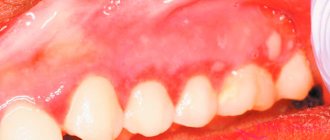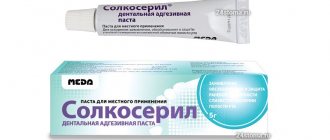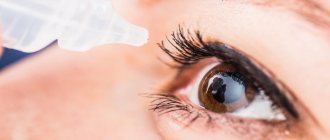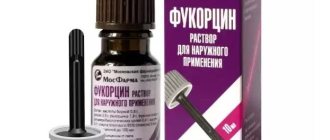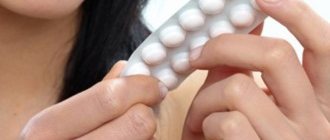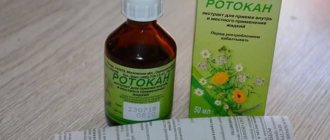Directions for use and doses
Externally, locally.
The treatment is carried out alternately with two tampons, generously moistened with Octenisept. The affected surface must be treated completely. The drug can be applied to easily accessible areas by spraying. Exposure time - at least 1–2 minutes.
The dressings are applied after Octenisept has completely dried (i.e. after 1–2 minutes). Before using the drug, the tissue areas to be treated must be cleaned of pus or other biosubstrates.
To rinse the mouth, use 20 ml of the drug; repeated rinsing is recommended after 20 s.
To prevent fungal diseases, the skin between the toes and feet is treated with the drug 2 times a day (morning and evening). Treatment period is up to 14 days.
OCTENISEPT (instructions)
PHARMACOLOGICAL PROPERTIES: Pharmacodynamics . The drug has a wide spectrum of antimicrobial action due to the hydrophobic interaction of octenidine dihydrochloride with the cytoplasmic membranes of pathogenic microorganisms and is synergistically enhanced by the action of phenoxyethanol. The spectrum of antimicrobial action covers spore-forming and asporogenic microflora, gram-positive and gram-negative bacteria (aerobic and anaerobic), fungi, viruses, including mycobacterium tuberculosis, streptococci, staphylococci, multidrug-resistant Staphylococcus aureus (MRSA), enterococci, gonococci, meningococci, pneumococci, Escherichia, shigella, Proteus, Pseudomonas aeruginosa, Corynebacterium diphtheria, Gardnerella, ascomycetes, dermatophytes, candida, herpes viruses, hepatitis B, C, D, HIV, chlamydia, mycoplasma, ureaplasma, trichomonas, other microbial flora resistant to chemotherapy drugs. The drug has no toxic effect and is not absorbed through the mucous membrane, skin and wound surfaces. The microcidal activity of the drug appears 30 s after application and has a prolonged effect. Destroys microorganisms without damaging tissue cells. The use of the drug promotes the healing of wounds and burns due to its immunomodulatory effect. Pharmacokinetics . Octenidine dihydrochloride is not absorbed through the skin and mucous membranes. Phenoxyethanol is absorbed in small quantities and excreted by the kidneys in the form of phenoxyacetylic acid.
INDICATIONS: antiseptic treatment of the mucous membrane and adjacent tissues, skin; treatment of wound surfaces (including umbilical wounds of newborns, purulent wounds in surgical and obstetric practice); bedsores, ulcers (including gangrenous); treatment of the surgical field before, during and after surgical, diagnostic and other manipulations; for injuries (including fractures), burns (deep and superficial); treatment of abrasions, cracks (for example, nipples during breastfeeding), postoperative sutures; treatment and prevention of inflammation of the genital organs, urinary tract (including sexually transmitted diseases); prevention and treatment of infections of the oral cavity, nasopharynx, eyes; antiseptic lavage of cavities (including the maxillary, frontal paranasal sinuses, abdominal cavity, bladder); washing the body of patients with multidrug-resistant Staphylococcus aureus. Hygienic and surgical treatment of personnel’s hands; prevention of nosocomial and professional infection with HIV and hepatitis when contagious material gets on the mucous membranes (including the eyes) and skin.
APPLICATION: before using the drug, it is recommended to clean the areas of skin and mucous membranes to be treated. The antiseptic is evenly applied to the skin and mucous membrane, to the wound surfaces - using a swab soaked in a sufficient amount of solution, or irrigated using a sprayer. The surface must be completely wet. After treatment, before applying bandages and stickers, you must wait for the treated surface to dry. When treating the body before aseptic surgical interventions, the incision site should first be treated, and then the surrounding areas of the skin. During a septic operation, treatment begins from the periphery. Antiseptic treatment of the surgical field should be carried out at least twice. For the treatment of wounds (including the umbilical wound of newborns), burns, and bedsores, Octenisept is used undiluted. The treatment is carried out using a tampon soaked in the solution, irrigation from a spray bottle or applying gauze bandages soaked in Octenisept. For the purpose of prevention and local treatment of inflammatory processes, for rinsing the mouth and nasopharynx, Octenisept should be diluted with distilled (boiled) water in a ratio of 1:3, rinsing is repeated after 20 minutes. For washing cavities (including the frontal and maxillary sinuses), nasal passages; for stomatitis, inflammation of the mucous membrane of the eyes, for the sanitation of carriers of diphtheria and staphylococci, the drug is diluted with distilled (boiled) water in a ratio of 1:6. For patients with diphtheria, the drug is recommended to be used by spraying. To wash the genitals in order to prevent inflammatory processes (including infections of various origins), Octenisept is diluted with distilled (boiled) water or physiological solution in a ratio of 1:6. In complex treatment of inflammatory processes (including infectious diseases) of the genital organs, the drug is used undiluted or, if necessary, diluted with distilled (boiled) water or physiological solution in a ratio of 1:2; 1:3. For acute and chronic urethritis, urethroprostatitis, the solution is injected into the urinary canal in a volume of 2–5 ml, the procedure is repeated 2–3 times a day. In order to prevent sexually transmitted diseases, it is recommended to use Octenisept after sexual intercourse. When using the drug to wash the body of patients with multidrug-resistant Staphylococcus aureus, the solution is diluted in a ratio of 1:2; 1:6 (before use, the solution can be warmed to body temperature). For prevention (for example, in athletes) and treatment of fungal diseases of the skin of the legs and feet, treatment of these areas with the drug is carried out 2 times a day (morning and evening) by spraying. The treated area of skin should be dry. The frequency of use of Octenisept is 2-3 times a day, if necessary - up to 6 times a day. Do not use in the area of the eardrum.
CONTRAINDICATIONS: hypersensitivity to the drug.
SIDE EFFECTS: possible short-term slight burning at the site of application; when rinsing the mouth - a bitter taste.
SPECIAL INSTRUCTIONS: When used in the oral cavity, do not swallow. If a significant amount of the drug accidentally enters the stomach, it should be rinsed with a sufficient amount of water and activated charcoal should be taken. If the drug concentrate accidentally gets into your eyes, they should be rinsed with running water. The use of the drug in the area of the eardrum is not allowed. During pregnancy and breastfeeding . During pregnancy, the drug can be used without restrictions. When used during breastfeeding to treat cracked nipples, avoid getting the drug into the baby’s gastrointestinal tract.
INTERACTIONS: simultaneous use with iodine-containing antiseptics is not recommended.
OVERDOSE: not noted.
STORAGE CONDITIONS: in a dry place, protected from light at temperatures from –5 °C to 25 °C. After opening the bottle, the antiseptic is stored for 3 years.
Use of the drug Octenisept
Before using the drug, it is recommended to clean the areas of skin and mucous membranes to be treated. The antiseptic is evenly applied to the skin and mucous membrane, to the wound surfaces - using a swab soaked in a sufficient amount of solution, or irrigated using a sprayer. The surface must be completely wet. After treatment, before applying bandages and stickers, you must wait for the treated surface to dry. When treating the body before aseptic surgical interventions, the incision site should first be treated, and then the surrounding areas of the skin. During a septic operation, treatment begins from the periphery. Antiseptic treatment of the surgical field should be carried out at least twice. For the treatment of wounds (including the umbilical wound of newborns), burns, and bedsores, Octenisept is used undiluted. The treatment is carried out using a tampon soaked in the solution, irrigation from a spray bottle or applying gauze bandages soaked in Octenisept. For the purpose of prevention and local treatment of inflammatory processes, for rinsing the mouth and nasopharynx, Octenisept should be diluted with distilled (boiled) water in a ratio of 1:3, rinsing is repeated after 20 minutes. For washing cavities (including the frontal and maxillary sinuses), nasal passages; for stomatitis, inflammation of the mucous membrane of the eyes, for the sanitation of carriers of diphtheria and staphylococci, the drug is diluted with distilled (boiled) water in a ratio of 1:6. For patients with diphtheria, the drug is recommended to be used by spraying. To wash the genitals in order to prevent inflammatory processes (including infections of various origins), Octenisept is diluted with distilled (boiled) water or physiological solution in a ratio of 1:6. In complex treatment of inflammatory processes (including infectious diseases) of the genital organs, the drug is used undiluted or, if necessary, diluted with distilled (boiled) water or physiological solution in a ratio of 1:2; 1:3. For acute and chronic urethritis, urethroprostatitis, the solution is injected into the urinary canal in a volume of 2–5 ml, the procedure is repeated 2–3 times a day. In order to prevent sexually transmitted diseases, it is recommended to use Octenisept after sexual intercourse. When using the drug to wash the body of patients with multidrug-resistant Staphylococcus aureus, the solution is diluted in a ratio of 1:2; 1:6 (before use, the solution can be warmed to body temperature). For prevention (for example, in athletes) and treatment of fungal diseases of the skin of the legs and feet, treatment of these areas with the drug is carried out 2 times a day (morning and evening) by spraying. The treated area of skin should be dry. The frequency of use of Octenisept is 2-3 times a day, if necessary - up to 6 times a day. Do not use in the area of the eardrum.
Pharmacological properties of the drug Octenisept
Pharmacodynamics . The drug has a wide spectrum of antimicrobial action due to the hydrophobic interaction of octenidine dihydrochloride with the cytoplasmic membranes of pathogenic microorganisms and is synergistically enhanced by the action of phenoxyethanol. The spectrum of antimicrobial action covers spore-forming and asporogenic microflora, gram-positive and gram-negative bacteria (aerobic and anaerobic), fungi, viruses, including mycobacterium tuberculosis, streptococci, staphylococci, multidrug-resistant Staphylococcus aureus (MRSA), enterococci, gonococci, meningococci, pneumococci, Escherichia, shigella, Proteus, Pseudomonas aeruginosa, Corynebacterium diphtheria, Gardnerella, ascomycetes, dermatophytes, candida, herpes viruses, hepatitis B, C, D, HIV, chlamydia, mycoplasma, ureaplasma, trichomonas, other microbial flora resistant to chemotherapy drugs. The drug has no toxic effect and is not absorbed through the mucous membrane, skin and wound surfaces. The microcidal activity of the drug appears 30 s after application and has a prolonged effect. Destroys microorganisms without damaging tissue cells. The use of the drug promotes the healing of wounds and burns due to its immunomodulatory effect. Pharmacokinetics . Octenidine dihydrochloride is not absorbed through the skin and mucous membranes. Phenoxyethanol is absorbed in small quantities and excreted by the kidneys in the form of phenoxyacetylic acid.
Special instructions for the use of the drug Octenisept
If used in the oral cavity, do not swallow. If a significant amount of the drug accidentally enters the stomach, it should be rinsed with a sufficient amount of water and activated charcoal should be taken. If the drug concentrate accidentally gets into your eyes, they should be rinsed with running water. The use of the drug in the area of the eardrum is not allowed. During pregnancy and breastfeeding . During pregnancy, the drug can be used without restrictions. When used during breastfeeding to treat cracked nipples, avoid getting the drug into the baby’s gastrointestinal tract.
Indications for use of the drug Octenisept
Antiseptic treatment of the mucous membrane and adjacent tissues, skin; treatment of wound surfaces (including umbilical wounds of newborns, purulent wounds in surgical and obstetric practice); bedsores, ulcers (including gangrenous); treatment of the surgical field before, during and after surgical, diagnostic and other manipulations; for injuries (including fractures), burns (deep and superficial); treatment of abrasions, cracks (for example, nipples during breastfeeding), postoperative sutures; treatment and prevention of inflammation of the genital organs, urinary tract (including sexually transmitted diseases); prevention and treatment of infections of the oral cavity, nasopharynx, eyes; antiseptic lavage of cavities (including the maxillary, frontal paranasal sinuses, abdominal cavity, bladder); washing the body of patients with multidrug-resistant Staphylococcus aureus. Hygienic and surgical treatment of personnel’s hands; prevention of nosocomial and professional infection with HIV and hepatitis when contagious material gets on the mucous membranes (including the eyes) and skin.
